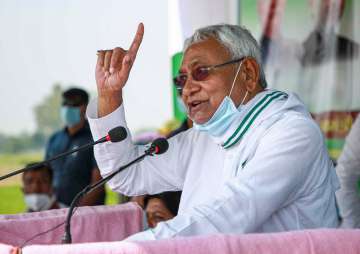Nitish Kumar: The Chanakya of Bihar politics
Nitish Kumar has earned an image of being suave and workaholic, credit his works in the last 15 years. Soft-spoken, sharp, and articulate, he speaks in a measured tone.

Nitish Kumar is the Chief Minister of Bihar and heads the Janata Dal (United). The 69-year-politician has been at the helm of state's affair since 2005. Nitish was born on March 1, 1951, in Bakhtiarpur. He belongs to the Kurmi caste. He earned a degree in engineering from Bihar College of Engineering (now NIT Patna) in 1972.
Nitish began his political career with the socialist class of politicians like Jayaprakash Narayan, Ram Manohar Lohia, Karpuri Thakur, and VP Singh. He took part in the JP movement in the 70s, and then joined the Janata Party.
Nitish was elected to the Legislative Assembly for the first time in 1985. In 1989, he supported Lalu Prasad Yadav for the Leader of Opposition's chair. It was in 1996 when Nitish switched his loyalty to the Bharatiya Janata Party and briefly served in the Atal Bihar Vajpayee's governments at the Centre.
Often referred to as the Chanakya of Bihar politics, Nitish Kumar served as the CM of Bihar for the first time from March 3, 2000, to March 10, 2000. He became the chief minister on November 24, 2005, with the BJP's support and since then he has been at the helm of state affairs.
The Janata Dal (United) was formed in 2003 with the merger of the Sharad Yadav faction of the Janata Dal, the Lokshakti Party, and the Samta Party. The JD(U) is recognised as a state party in the states of Bihar and Arunachal Pradesh.
Nitish has earned an image of being suave and workaholic, credit his works in the last 15 years. Soft-spoken, sharp, and articulate, he speaks in a measured tone. He has answers ready always with a subtle fact. He is also widely known as the 'Sushashan Babu' (good governance man) for establishing the rule of law in Bihar that was infamous for kidnapping, loot, murder during the 90s.
But then came a dramatic moment in 2013. In June 2013, Nitish broke ties with the BJP after the latter declared Narendra Modi as its prime ministerial candidate for 2014 general elections. His breakaway from the BJP stunned the nation, as did his resignation from the chief minister's post after the JD(U)'s massive Lok Sabha defeat in May 2014 and elevation of Jitan Ram Manjhi as chief minister and then pulling the latter down to assume power again in February 2015 for a fourth term. He sided with arch-rival Lalu Prasad Yadav in February 2015 and contested the Assembly elections together. The alliance secured a comfortable majority and Nitish returned to the CM's chair with the RJD having a handsome representation in the Cabinet.
Persuasive, sometimes adamant, Nitish is known to carry strong likes and dislikes. And this was evident in his July 2017 decision to dissolve the grand alliance and again join the ranks with the BJP to form the government. Nitish had realised that his clean image was at stake with a series of corruption charges against the RJD leaders, especially the sons of Lalu. An uneasiness prevailed in the alliance for very long and it lasted for barely two years with corruption allegation against deputy CM Tejashwi Yadav and Tej Pratap Yadav. It was never easy for Nitish as the RJD lost no opportunity to press that it was the major partner in the alliance.
In the 2019 Lok Sabha elections, Nitish's party contested with the BJP and won 16 of the 17 seats. His party is contesting the 2020 Assembly elections in Bihar with the BJP and seeking a fourth consecutive win.